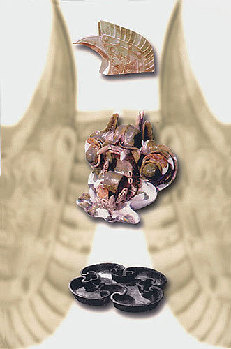Site of the capital of State ofBohai, local government located in northeastern part of Tang Empire
Location: Ning'an,HeilongjiangProvince
Period: 750-926 AD
Excavated in 1933
Significance: It has offered important material objects for the study of the political, economic and cultural developments in the northeastern part of the Tang Dynasty (618-907), as well as the relationships between the local culture and the Tang culture.
 Introduction
Introduction
The Capital City Longquanfu is also called Shangjing Longquanfu of theBohaiState.
|

|
| Tri-colored tail of owl: piece of building (up, height 97 cm); Glazed pottery animal head: piece of building (mid, height 39 cm); Polished black pottery tray in the shape of a piece of cloud: utensil for daily life (bottom, length 86 cm) |
TheBohaiStatewas a kingdom that existed from 750 to 926 AD in the northeastern part of today'sChina. It was formed by the Tungusic people in association with the refugees from Koguryo. It actively imported Chinese culture and political systems and boasted a high standard of civilization.
From the reports of these researches, it is known that Shangjing Longquanfu is the most important ruins having triply nested structure consisting of rectangular innermost, inner and outer city and grid-pattern streets. This method of planning was borrowed from Tang's capital Chang'an. The outer city was 17.5 kilometers with altogether 10 city gates on the four sides and an entrenchment in front. In the city there were grid-pattern streets dividing it into many quadrate residence areas. The inner city was located in the middle of the northern outer city, while the innermost city in the center of the inner city. In the south of the innermost city was a pond with an area of about 20,000 square meters.
While being a close follower of the Tang political and cultural systems, Bohai might have maintained the indigenous culture such as hill-fort system, which is peculiar to the region covering northeasternChinaand northern part of the Korean peninsula.
